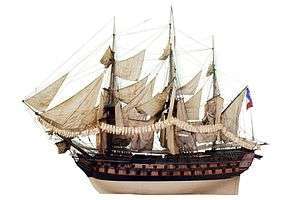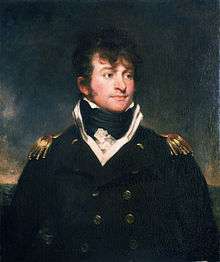French ship Viala (1795)
 Scale model of Achille, sister ship of French ship Viala (1795), on display at the Musée de la Marine in Paris. | |
| History | |
|---|---|
| Name: | Viala |
| Namesake: | Joseph Agricol Viala |
| Builder: | Lorient |
| Launched: | 1795 |
| Renamed: |
Voltaire in 1795 Constitution in 1795 Jupiter in 1803 |
| Name: | Maida |
| Namesake: | Battle of Maida |
| Fate: | Broken up in June 1817. |
| General characteristics | |
| Class and type: | Téméraire-class ship of the line |
| Displacement: | 2900 tonnes |
| Tons burthen: | 1,899 tons (bm) |
| Length: | 55.87 m (183.3 ft) (172 French feet) |
| Beam: | 14.90 m (48.9 ft) (44' 6) |
| Draught: | 7.26 m (23.8 ft) (22 French feet) |
| Sail plan: | Full-rigged ship (sail area up to 2485 m²) |
| General characteristics (French service) | |
| Complement: | 3 officers + 690 men |
| Armament: |
|
| General characteristics (British service[1]) | |
| Complement: | 121 officers and enlisted |
| Armament: |
|
Viala was a 74-gun Téméraire-class ship of the line of the French Navy launched in 1795. The Royal Navy captured her in 1806 and sold her in 1814.
French service
Between 1794 and 1795, the French successively named her Viala (in honour of Joseph Agricol Viala), Voltaire (in honour of François-Marie Arouet), and Constitution (after the Constitution of the National Convention).
In the winter of 1796-1797, she took part in the Expédition d'Irlande. She managed to reach Bantry Bay, where she was damaged in a collision with Révolution.
In 1802, she was recommissioned in Toulon, under Captain Faure.
In 1803, she was renamed again to Jupiter, and joined Vice-Admiral Corentin Urbain Leissègues's squadron bound for Santo Domingo, under Captain Laignel. Donegal, while serving in a Royal Navy squadron under the command of Vice Admiral Duckworth, captured her at the Battle of San Domingo (6 February 1806). In the battle, Jupiter lost some 200 men killed and wounded; Donegal had 12 men killed and 33 wounded.[2][Note 1]
British service
Jupiter arrived in Portsmouth on 6 May 1805.[1] The Royal Navy then commissioned her as Maida, in honour of the Battle of Maida, the name Jupiter being already used for the 50-gun fourth rate Jupiter.
She was commissioned in February 1807 under Captain Samuel Hood Linzee.[1]

Maida was one of the vessels at the Second Battle of Copenhagen. There she landed a party of seamen who manned the breaching battery before the city. Because she was one of the vessels present at the seizure of the Danish fleet on 7 September, her officers and crew were entitled to share in the prize money.[Note 2] By the end of the year she was back in Portsmouth.
On 26 October 1807, Tsar Alexander I of Russia declared war on Great Britain. The official news did not arrive there until 2 December, at which time the British declared an embargo on all Russian vessels in British ports. Maida was one of some 70 vessels that shared in the proceeds of the seizure of the 44-gun Russian frigate Speshnoy (Speshnyy), and the Russian storeship Wilhelmina (or Vilghemina) then in Portsmouth harbour.[5] The Russian vessels were carrying the payroll for Vice-Admiral Dmitry Senyavin’s squadron in the Mediterranean.[6][Note 3]
Maida was paid off at Portsmouth on 9 March 1808 and placed into ordinary. In 1813 she came under the command of Captain John Hayes. She remained in ordinary, i.e., she was not recommissioned, but served as flagship at Portsmouth to Rear-Admiral Edward Griffith Colpoys.[1]
Fate
On 25 July 1814 the Principal Officers and Commissioners of His Majesty's Navy put her up for sale. The conditions of sale included that the purchaser was to give a bond, with two sureties for ₤3000, that they would not sell or otherwise dispose of the ship but that they would break her up within twelve months from the date of sale.[8] She was sold on 11 August 1814 for £4,700.[1]
Footnotes
- Notes
- Citations
- 1 2 3 4 5 Winfield (2008), p.89.
- ↑ The London Gazette: no. 15902. pp. 371–374. 24 March 1806.
- ↑ The London Gazette: no. 16088. p. 1545. 17 November 1817.
- ↑ The London Gazette: no. 16275. p. 1103. 11 July 1809.
- ↑ The London Gazette: no. 16276. p. 1129. 15 July 1809.
- ↑ Tredea & Sozaev (2010), p. 198 & p.391.
- ↑ The London Gazette: no. 16195. p. 1460. 25 October 1808.
- ↑ The London Gazette: no. 16922. p. 1566. 2 August 1814.
References
- Roche, Jean-Michel (2005) Dictionnaire des Bâtiments de la Flotte de Guerre Française de Colbert à nos Jours. (Group Retozel-Maury Millau).
- Tredrea, John and Eduard Sozaev (2010) Russian Warships in the Age of Sail, 1696-1860. Seaforth Publishing. ISBN 978-1-84832-058-1.
- Winfield, Rif (2008), British Warships in the Age of Sail 1793–1817: Design, Construction, Careers and Fates, Seaforth, ISBN 1-86176-246-1
External links
- Naval Database
- "HMS Maida (1806)". Michael Phillips’ Ships of the Old Navy. Retrieved 19 December 2011.